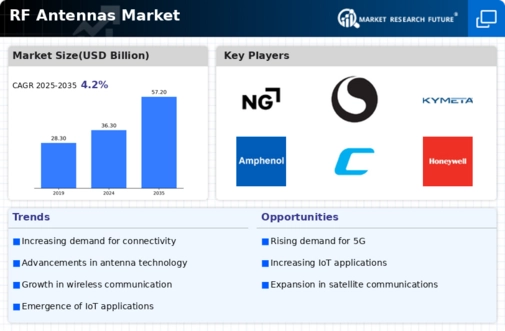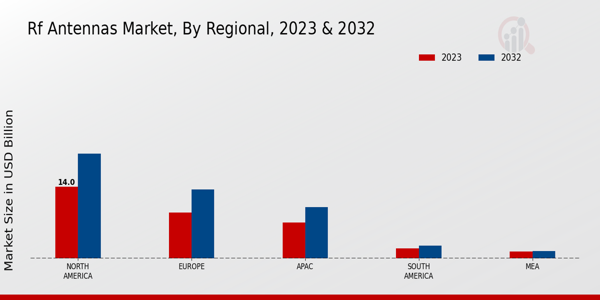Expansion of 5G Networks
The rollout of 5G networks worldwide is a significant catalyst for the Global RF Antennas Market Industry. With the promise of higher speeds and lower latency, 5G technology demands advanced antenna systems capable of supporting its infrastructure. As countries invest heavily in 5G deployment, the market is anticipated to expand, reaching an estimated 57.2 USD Billion by 2035. This expansion not only enhances mobile broadband services but also facilitates the growth of smart cities and autonomous vehicles, further driving the need for sophisticated RF antennas. The Global RF Antennas Market Industry is thus likely to experience substantial growth as 5G adoption accelerates.
Market Growth Projections
The Global RF Antennas Market Industry is projected to experience substantial growth over the coming years. With a market value of 36.3 USD Billion in 2024, it is anticipated to reach 57.2 USD Billion by 2035. This growth trajectory suggests a compound annual growth rate (CAGR) of 4.23% from 2025 to 2035. Such projections indicate a robust demand for RF antennas driven by advancements in technology, increased connectivity, and the expansion of 5G networks. The market dynamics reflect a favorable environment for stakeholders, as the Global RF Antennas Market Industry continues to evolve and adapt to emerging trends.
Advancements in Antenna Technology
Technological innovations in antenna design and materials are propelling the Global RF Antennas Market Industry forward. Developments such as MIMO (Multiple Input Multiple Output) technology and beamforming techniques enhance the performance and efficiency of antennas. These advancements allow for better signal quality and increased data throughput, which are essential for modern communication systems. As industries adopt these technologies, the market is expected to grow steadily, with a projected CAGR of 4.23% from 2025 to 2035. This growth trajectory indicates a strong future for the Global RF Antennas Market Industry, driven by continuous improvements in antenna capabilities.
Rising Adoption of Smart Technologies
The proliferation of smart technologies across various sectors is influencing the Global RF Antennas Market Industry. Smart homes, smart grids, and industrial automation require reliable communication systems, which in turn depend on efficient RF antennas. As consumers and businesses increasingly adopt these technologies, the demand for antennas that can support diverse applications is likely to grow. This trend is indicative of a broader shift towards automation and connectivity, further propelling the market forward. The Global RF Antennas Market Industry is expected to capitalize on this growing adoption, as it aligns with the increasing need for seamless communication in smart environments.
Growing Demand for Wireless Communication
The increasing reliance on wireless communication technologies is a primary driver of the Global RF Antennas Market Industry. As mobile devices and IoT applications proliferate, the need for efficient RF antennas becomes paramount. In 2024, the market is projected to reach 36.3 USD Billion, reflecting a robust demand for antennas that can support high-frequency applications. This trend is likely to continue as the number of connected devices is expected to surge, necessitating advanced antenna solutions that can handle diverse communication protocols. The Global RF Antennas Market Industry is thus positioned to benefit significantly from this ongoing shift towards wireless connectivity.
Increased Investment in Defense and Aerospace
The defense and aerospace sectors are witnessing heightened investments, which significantly impact the Global RF Antennas Market Industry. Advanced communication systems are critical for military operations, necessitating the development of specialized RF antennas. Governments are allocating substantial budgets for defense modernization, which includes upgrading communication technologies. This trend is expected to bolster the market, as the demand for high-performance antennas in defense applications continues to rise. The Global RF Antennas Market Industry stands to gain from these investments, as they drive innovation and enhance the capabilities of RF antenna systems.




















